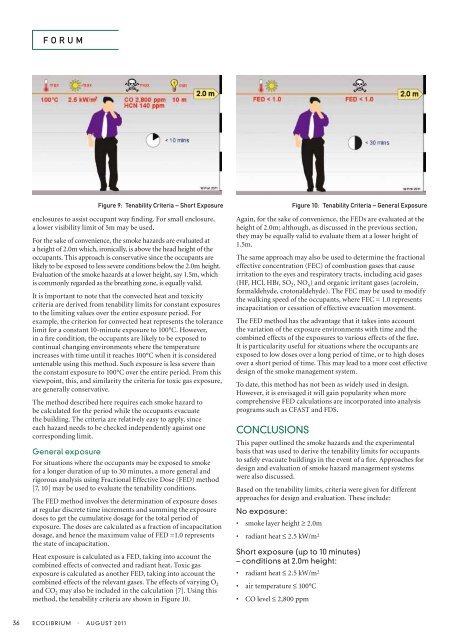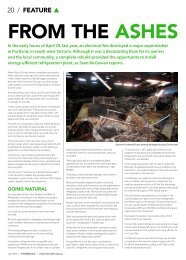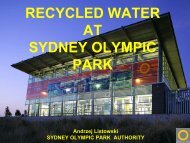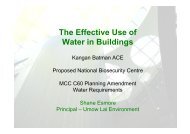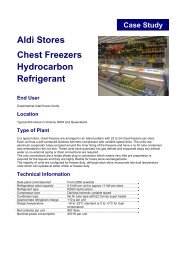Tenability criteria for design of smoke hazard management ... - Airah
Tenability criteria for design of smoke hazard management ... - Airah
Tenability criteria for design of smoke hazard management ... - Airah
Create successful ePaper yourself
Turn your PDF publications into a flip-book with our unique Google optimized e-Paper software.
36<br />
FORUM<br />
enclosures to assist occupant way finding. For small enclosure,<br />
a lower visibility limit <strong>of</strong> 5m may be used.<br />
For the sake <strong>of</strong> convenience, the <strong>smoke</strong> <strong>hazard</strong>s are evaluated at<br />
a height <strong>of</strong> 2.0m which, ironically, is above the head height <strong>of</strong> the<br />
occupants. This approach is conservative since the occupants are<br />
likely to be exposed to less severe conditions below the 2.0m height.<br />
Evaluation <strong>of</strong> the <strong>smoke</strong> <strong>hazard</strong>s at a lower height, say 1.5m, which<br />
is commonly regarded as the breathing zone, is equally valid.<br />
It is important to note that the convected heat and toxicity<br />
<strong>criteria</strong> are derived from tenability limits <strong>for</strong> constant exposures<br />
to the limiting values over the entire exposure period. For<br />
example, the criterion <strong>for</strong> convected heat represents the tolerance<br />
limit <strong>for</strong> a constant 10-minute exposure to 100°C. However,<br />
in a fire condition, the occupants are likely to be exposed to<br />
continual changing environments where the temperature<br />
increases with time until it reaches 100°C when it is considered<br />
untenable using this method. Such exposure is less severe than<br />
the constant exposure to 100°C over the entire period. From this<br />
viewpoint, this, and similarity the <strong>criteria</strong> <strong>for</strong> toxic gas exposure,<br />
are generally conservative.<br />
The method described here requires each <strong>smoke</strong> <strong>hazard</strong> to<br />
be calculated <strong>for</strong> the period while the occupants evacuate<br />
the building. The <strong>criteria</strong> are relatively easy to apply, since<br />
each <strong>hazard</strong> needs to be checked independently against one<br />
corresponding limit.<br />
general exposure<br />
For situations where the occupants may be exposed to <strong>smoke</strong><br />
<strong>for</strong> a longer duration <strong>of</strong> up to 30 minutes, a more general and<br />
rigorous analysis using Fractional Effective Dose (FED) method<br />
[7, 10] may be used to evaluate the tenability conditions.<br />
The FED method involves the determination <strong>of</strong> exposure doses<br />
at regular discrete time increments and summing the exposure<br />
doses to get the cumulative dosage <strong>for</strong> the total period <strong>of</strong><br />
exposure. The doses are calculated as a fraction <strong>of</strong> incapacitation<br />
dosage, and hence the maximum value <strong>of</strong> FED =1.0 represents<br />
the state <strong>of</strong> incapacitation.<br />
Heat exposure is calculated as a FED, taking into account the<br />
combined effects <strong>of</strong> convected and radiant heat. Toxic gas<br />
exposure is calculated as another FED, taking into account the<br />
combined effects <strong>of</strong> the relevant gases. The effects <strong>of</strong> varying O2 and CO2 may also be included in the calculation [7]. Using this<br />
method, the tenability <strong>criteria</strong> are shown in Figure 10.<br />
eColibRiuM • Augu St 2011<br />
Figure 9: <strong>Tenability</strong> Criteria – Short Exposure Figure 10: <strong>Tenability</strong> Criteria – General Exposure<br />
Again, <strong>for</strong> the sake <strong>of</strong> convenience, the FEDs are evaluated at the<br />
height <strong>of</strong> 2.0m; although, as discussed in the previous section,<br />
they may be equally valid to evaluate them at a lower height <strong>of</strong><br />
1.5m.<br />
The same approach may also be used to determine the fractional<br />
effective concentration (FEC) <strong>of</strong> combustion gases that cause<br />
irritation to the eyes and respiratory tracts, including acid gases<br />
(HF, HCl, HBr, SO2, NOx) and organic irritant gases (acrolein,<br />
<strong>for</strong>maldehyde, crotonaldehyde). The FEC may be used to modify<br />
the walking speed <strong>of</strong> the occupants, where FEC = 1.0 represents<br />
incapacitation or cessation <strong>of</strong> effective evacuation movement.<br />
The FED method has the advantage that it takes into account<br />
the variation <strong>of</strong> the exposure environments with time and the<br />
combined effects <strong>of</strong> the exposures to various effects <strong>of</strong> the fire.<br />
It is particularity useful <strong>for</strong> situations where the occupants are<br />
exposed to low doses over a long period <strong>of</strong> time, or to high doses<br />
over a short period <strong>of</strong> time. This may lead to a more cost effective<br />
<strong>design</strong> <strong>of</strong> the <strong>smoke</strong> <strong>management</strong> system.<br />
To date, this method has not been as widely used in <strong>design</strong>.<br />
However, it is envisaged it will gain popularity when more<br />
comprehensive FED calculations are incorporated into analysis<br />
programs such as CFAST and FDS.<br />
CoNCluSioNS<br />
This paper outlined the <strong>smoke</strong> <strong>hazard</strong>s and the experimental<br />
basis that was used to derive the tenability limits <strong>for</strong> occupants<br />
to safely evacuate buildings in the event <strong>of</strong> a fire. Approaches <strong>for</strong><br />
<strong>design</strong> and evaluation <strong>of</strong> <strong>smoke</strong> <strong>hazard</strong> <strong>management</strong> systems<br />
were also discussed.<br />
Based on the tenability limits, <strong>criteria</strong> were given <strong>for</strong> different<br />
approaches <strong>for</strong> <strong>design</strong> and evaluation. These include:<br />
No exposure:<br />
• <strong>smoke</strong> layer height ≥ 2.0m<br />
• radiant heat ≤ 2.5 kW/m 2<br />
Short exposure (up to 10 minutes)<br />
– conditions at 2.0m height:<br />
• radiant heat ≤ 2.5 kW/m2 • air temperature ≤ 100°C<br />
• CO level ≤ 2,800 ppm


